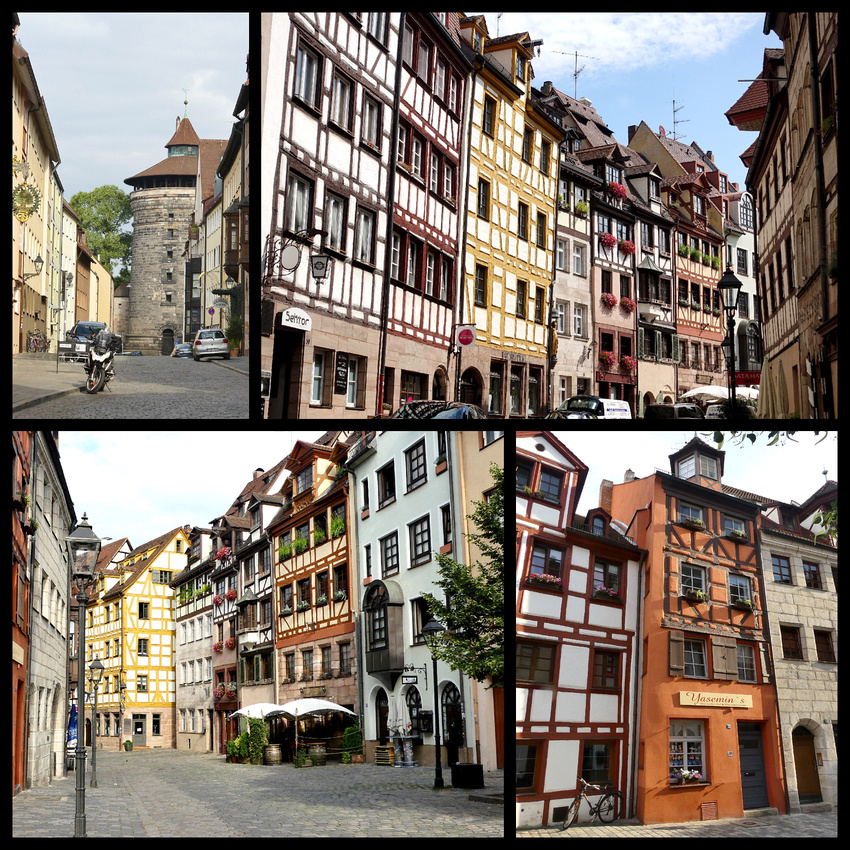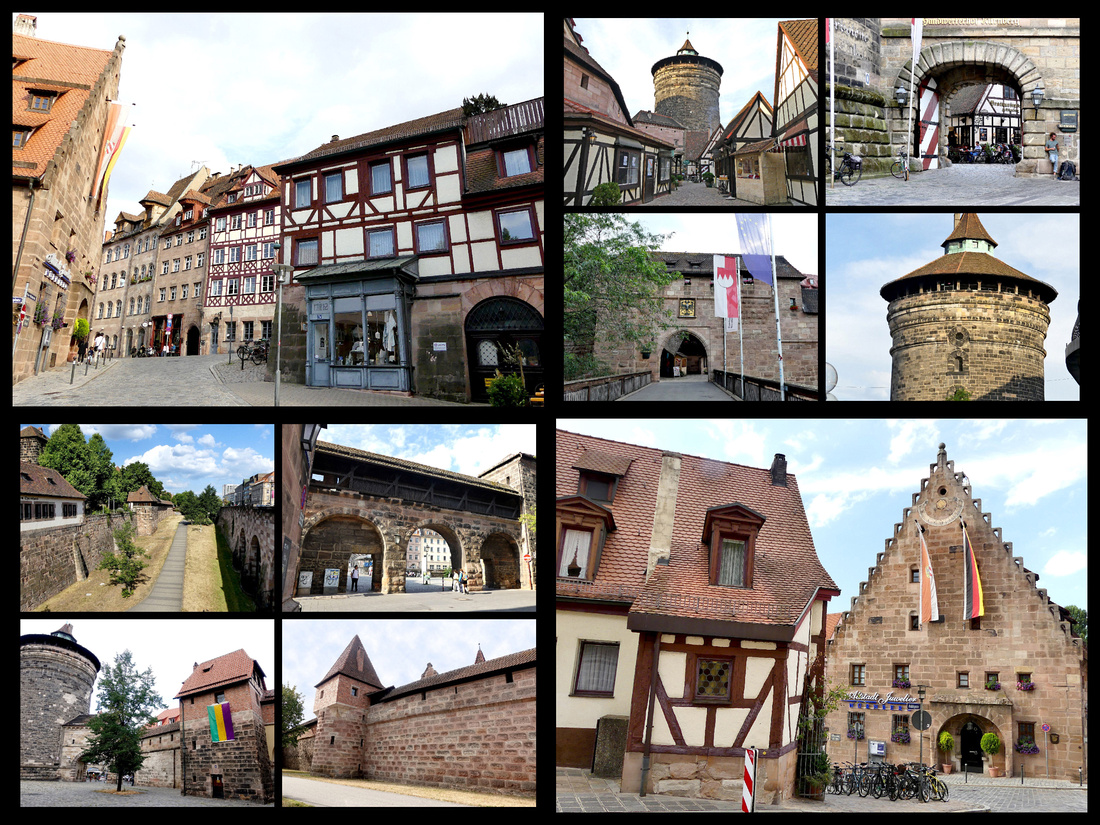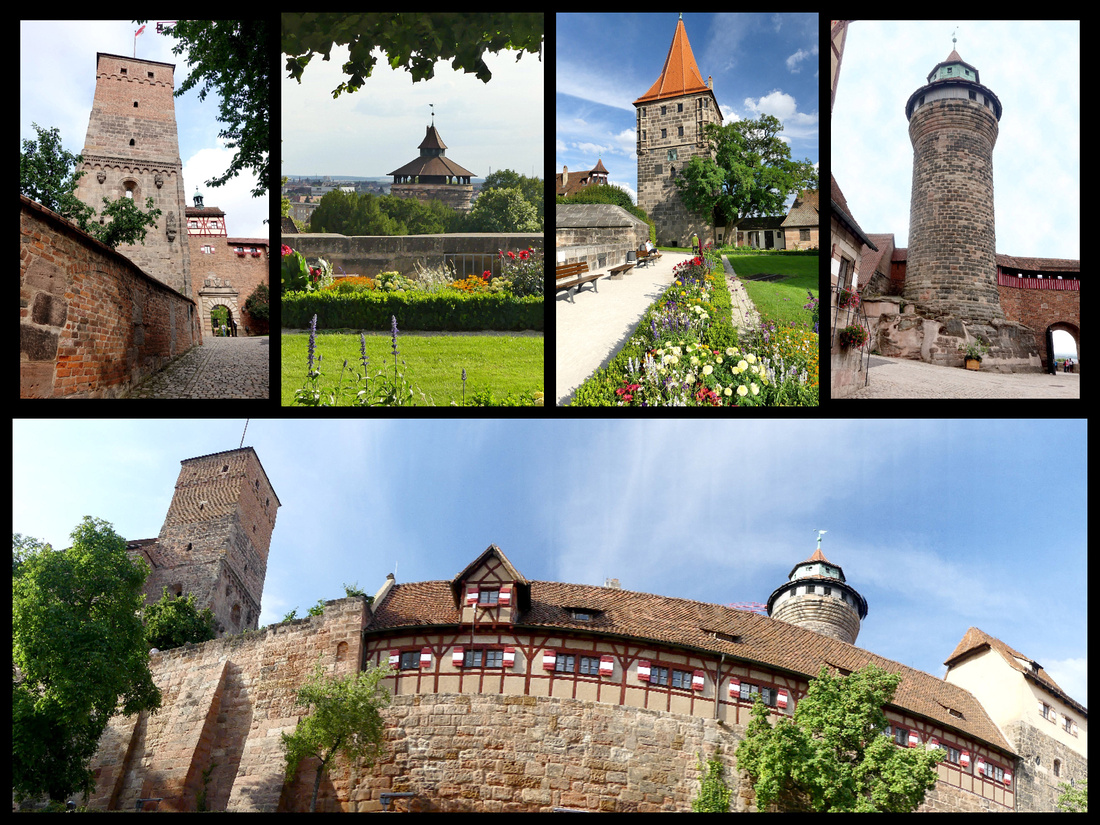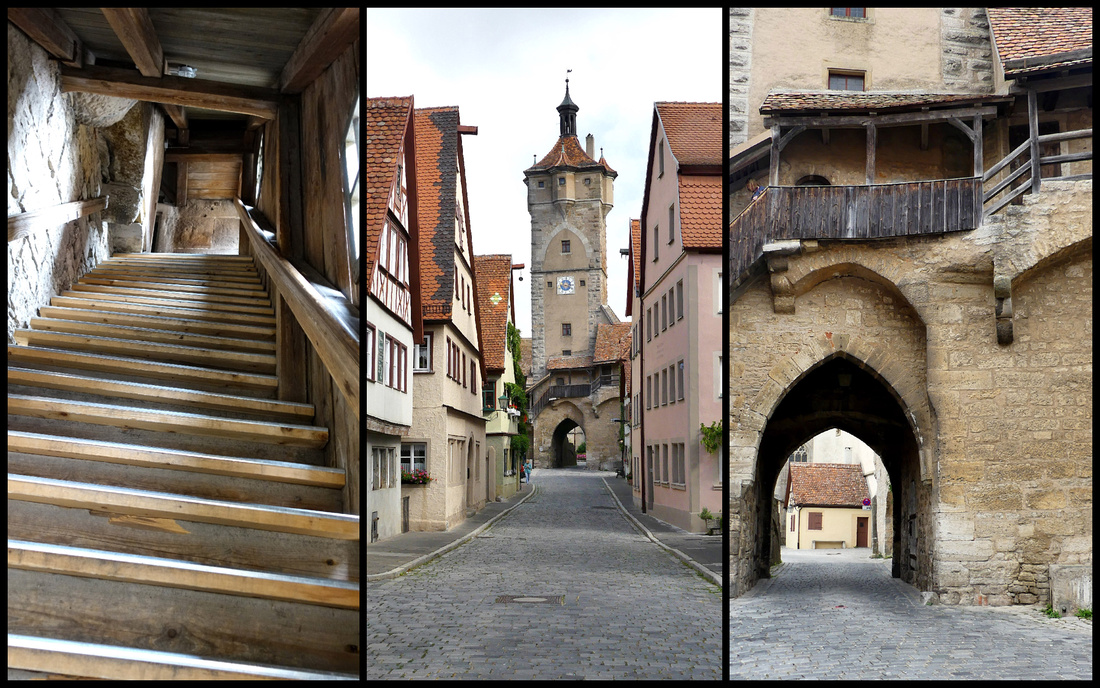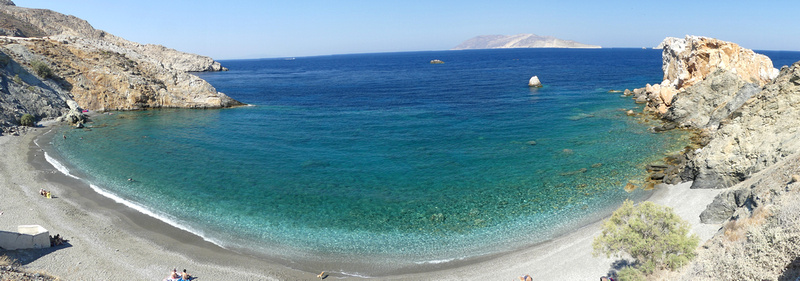


Bavaria to Bratislava and Back - Part 2: Bavaria
After Hallstatt, Graz, Bratislava and the Wachu Valley we returned to Bavaria including: Passau, Nurnberg, Bamberg, Regensberg, Rothenburg, and Heidelburg - that's a lot of 'burgs'.
Day 13 - From Melk to Nurnberg via Passau -
The trip from Melk to our next stop, Nurnberg was the longest, over five hours and when I discovered that it was actually considerably cheaper to book a train from Melk to Passau, and another 4 hours later on to Nurnberg I decided it would make a nice stopover. This was my fist experience with ‘left luggage’ and it went great. There were lockers, in several sizes, one medium one fit both bags, €4 (for up to 24 hours). Not all stations have left luggage lockers, some have no option at all, others have a ‘room’. Left luggage in Bratislava was a room with a desk and no guy at it when we passed. Much more sketchy. But with the lockers you didn’t have to worry about schedules or guys taking breaks or anything.
Passau made a great 4 hour stopover. Had plenty of time to explore the old town, climb up to the castle, have a lunch at the Rathaus beer garden. Passau’s main feature is it’s setting at the confluence of the Danube and the Inn Rivers- it comes to a sharp point where the two rivers meet. On one side is a fortress/castle, the other an abbey. The alstadt is about a 15-minute pleasant walk on mostly pedestrian shopping streets from the train station. The Dom is huge and very pretty both inside and out. There’s a nice square behind it with cafes and a fountain. The rathaus is a gorgeous medieval building, right on the river across from the fortress, great huge clock tower. There are a few other churches, some medieval winding lanes, a promenade all along both sides of the peninsula along both the Danube and the Inn. On the Danube were multiple riverboat cruise ships. I think Passau probably saw a ten-fold increase in tourists once those cruises caught on, the place was crawling with silver haired tourists.
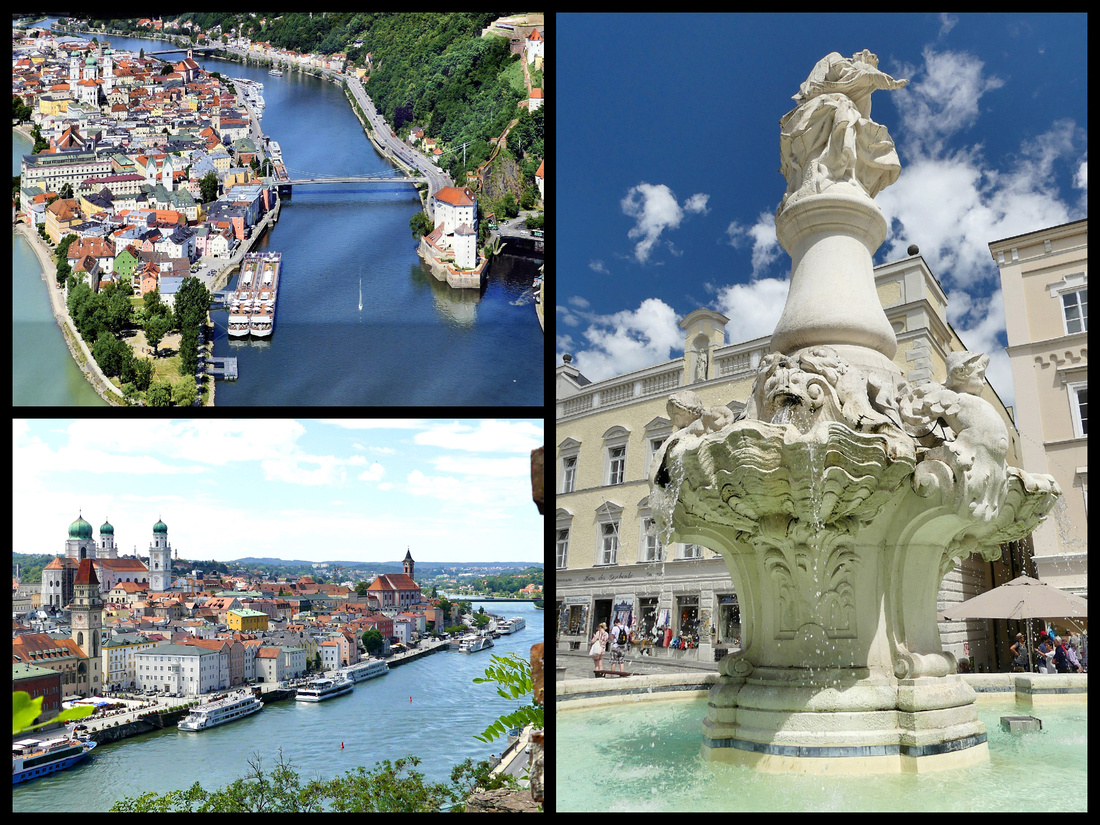
 Top left: view of Passau (from a poster) Lower left: view from the castle Right: fountain in the square behind the cathedral
Top left: view of Passau (from a poster) Lower left: view from the castle Right: fountain in the square behind the cathedral
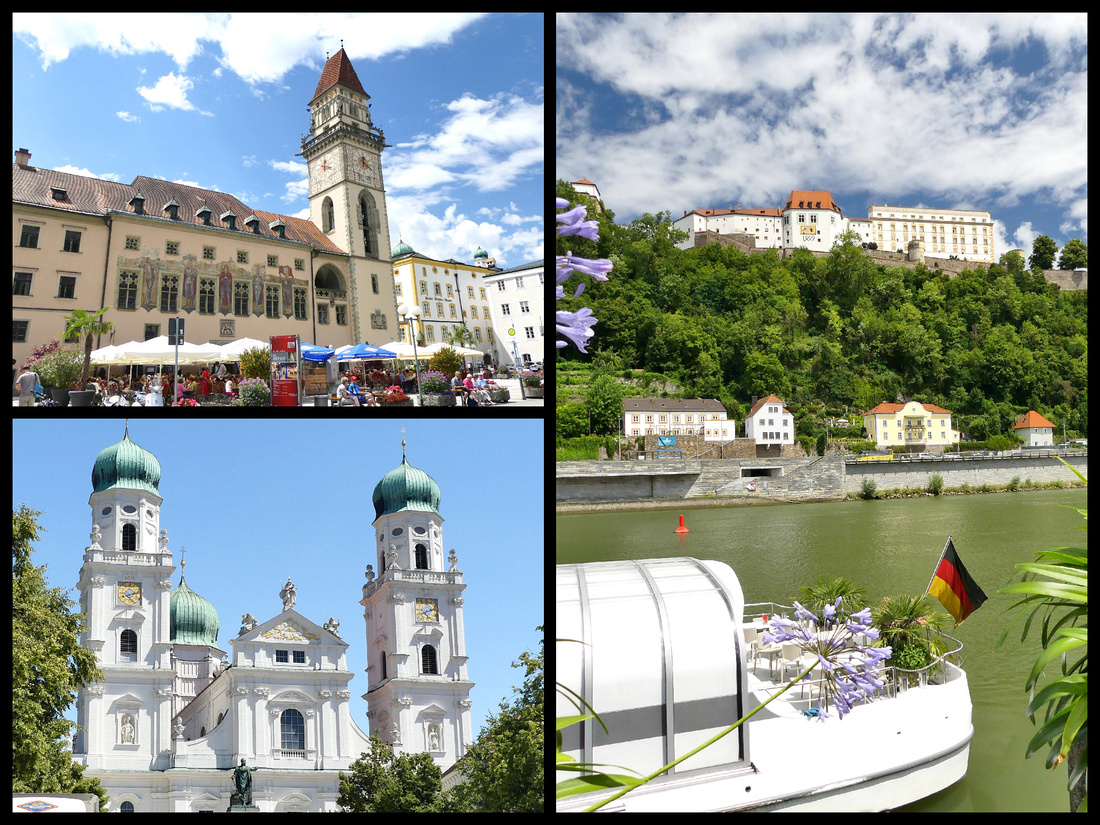

Passau was founded by the Celts over 2000 years ago, making it one of the oldest cities in Bavaria and is the last town on the Danube before the border with Austria. The city rests at the confluence of three rivers, Inn, Ilz and Danube, hence the nickname “City of Three Rivers.” The Schaibling Tower or Schaiblingturm has stood as a witness of the medieval fortifications of Passau since the 14th century.. Located on the banks of river Inn, the tower’s name is derived from the conical shape of its masonry: disc- Schaibling. It was part of the old salt boat harbor in Passau.
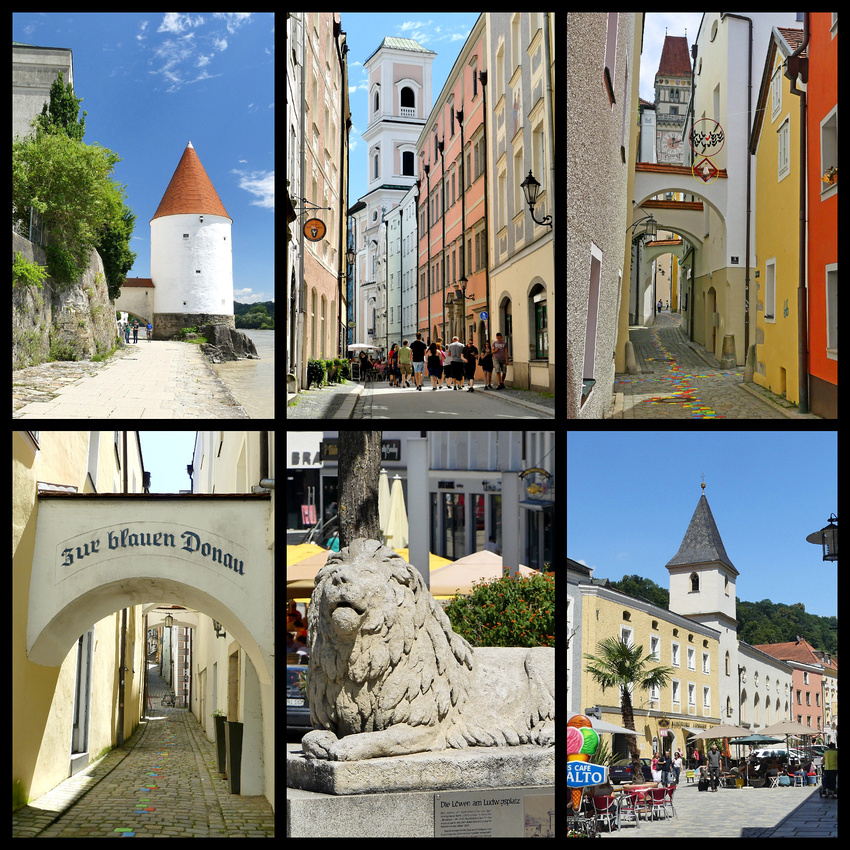

Days 14-16 We decided to base in Nurnberg for three nights as we had several one and two nights stays so far and though it might be more relaxing to have three nights in one place, and Nurnberg is centrally located between Bamberg and Regensberg. We wanted to see Nurnberg itself of course, but were surprised when it turned out to be our favorite of the three cities.
Hotel BB Nurnberg City is modern, 6 stories, 10 min walk from train station on main road, right next to opera house. Very clean and even a bit of a view of the church steeples. The Nurnberg train station is a classic northern European old style train station and is right across the street from the city walls and one of the main towers. Plus it had a great selection of decent food. Best train station food court I think I’ve ever seen (kind of like NY Grand Central’s). There is a fresh seafood restaurant (Nordsee, a chain); Japanese; ‘Dean & David’ which is fresh pressed juices, salads, wraps; Der Beck (German chain bakery with croissants, sandwiches, etc.; a pretzel sandwich place; decent looking pizza; and of course a place selling bratwurst, etc.
The first evening we were able to walk across the old town to the castle and back, across the river on some really pretty bridges, through nice squares and neighborhoods. Took about 1½ hours at a leisurely pace. We also had a couple of other mornings and two more evenings and felt we had a good amount of time to explore the city. We didn’t get to the WWII sites, which are a bit out of the center, but for us those were not a priority. We did have time to tour the castle and the Albrecht Durer House Museum.
During the 15th and 16th centuries, Nürnberg enjoyed a cultural flowering that made it the center of the German Renaissance, a northern Florence. So enamored was Adolf Hitler with the Nürnberg’s huge swaths of half-timbered houses, steeped and gabled rooftops, and cobbled lanes and squares that he chose to stage his massive Nazi rallies in what he considered to be the most German of German cities. Today probably the most picturesque part of the city is Weissgerber-grasse (Tanner’s Lane) – the largest ensemble of old artisan houses in Nurmberg.
As the ideological center of the Third Reich, the city was a choice target for Allied bombers and much of the city was seriously damaged or destroyed and therefore today there are quite a lot of fairly ugly mid 20th century buildings. But a lot has been restored and the city is really very pretty. The Pegnitz River runs through the center and there are numerous lovely bridges.


Lower left and center photos: Kettensteg is a ‘chain’ bridge, right up against the walls and one of the best preserved towers.
Handwerkerhof, just inside the walls across from the station (an underground passage leads from the station to the top of Königstrasse, the street that cuts through the old city) is an area of very touristy shops and restaurants but looks fairly medieval. It’s the start of an impressive stretch of old walls (interspersed with gates and towers) that stretches all along the west side of the city to the castle on the opposite side of the Alstatdt and site of the Königstorturm (tower) and Königstor Gate.
St Lorenz, the city’s largest church was heavily damaged but rebuilt impressively to its 14th century Gothic look. Across Lorenzer-platz is the 13th century Nassauer Hause – a great example of a medieval upper class house. In front of it is the 1589 Fountain of Virtue. And just a few steps past this is the Heilig-Geist Spital (Hospital of the Holy Spirit), 1332, beautifully reflected in the river. And just past this, completing the ‘heart’ of the old city, is the Hauptmarakt, the central market square with the Frauenkirche, 1352, and full of produce, food and flower stalls. At the opposite corner of this square is the Schoner Brunnen (Beautiful Fountain), 1396 adorned with 30 figures arranged in four tiers and a golden ring. Off this corner of the square if the Altes Rathaus, and across the street from this is St Sebaldus, a 14th century gothic church.
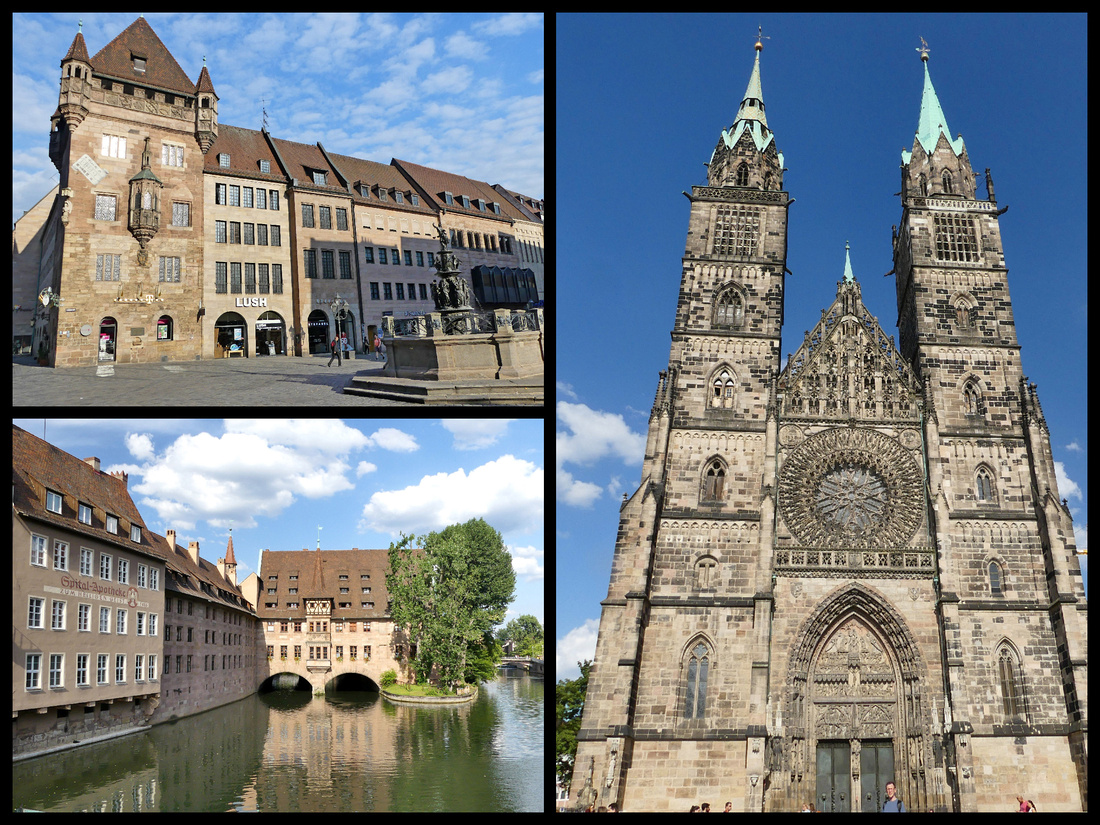
 Top left: Nassauer Hause Lower left: Hellig-Geist Spital Right: St Lorenz
Top left: Nassauer Hause Lower left: Hellig-Geist Spital Right: St Lorenz


Lower left: Frauen-kirche Lower right: street leading past the rathaus toward the castle
There are atmospheric cobblestoned streets between the Hauptmarakt and the castle and the most picturesque square in the city, at the junction of Neutormauer and Albrecht-Durer-strasse, full of half timbered houses and lined with the best section of old city wall and the Tiergartnertor (tower). Also here is the Albrecht-Durer House/Museum where the artist/engraver lived between 1509 and 1528. It is the oldest house in Nurnberg.
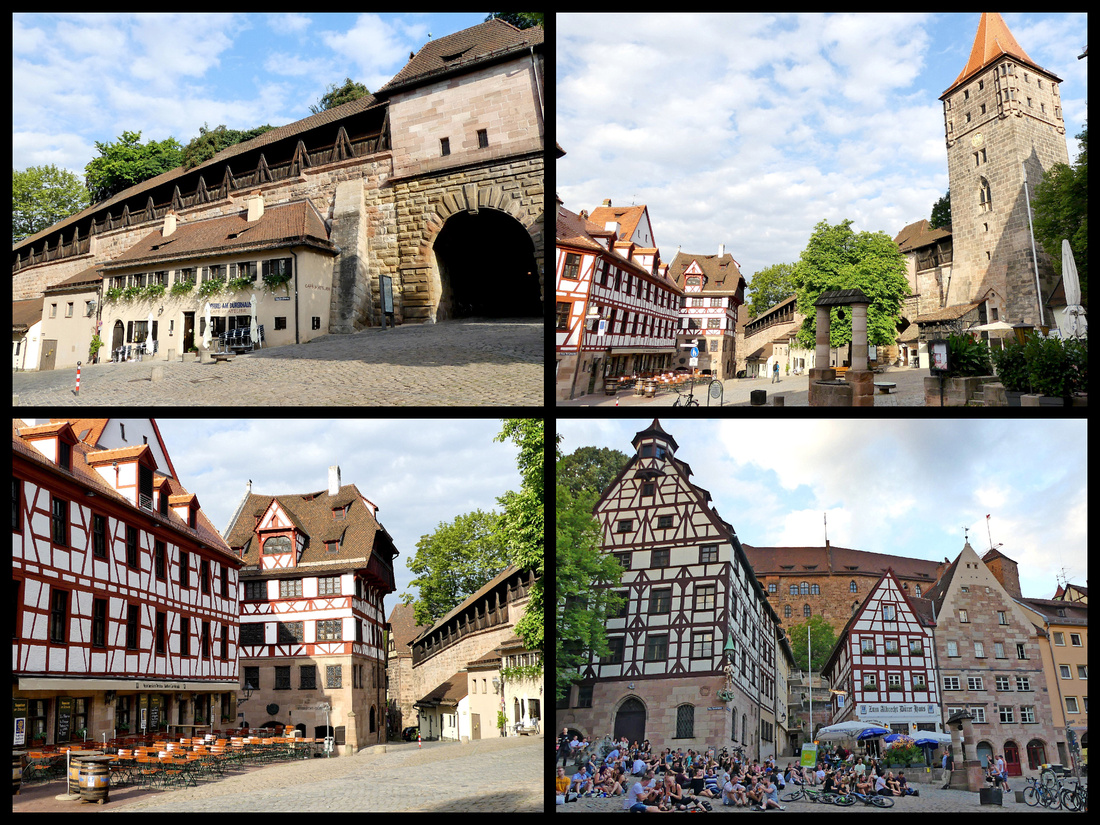

Nurnberg Kaiserburg – a large hilltop fortress at the northern edge of the Alstadt, begun in 1050 and added to over centuries. There are several buildings, one including an interesting 3 level Romanesque chapel open, but the highlights are the ‘deep’ well and the Sinwell Tower (a large round tower which can be climbed). Behind the castle are fairly extensive gardens with views over the town and the walls.


Another interesting area of town includes a corner of the walls and just inside the city from that, the Weisser turm (White tower – but it’s actually more pink), originally a tollgate from 1250. And right next to it a really interesting fountain called the Ehekarussell, or marriage fountain, it depicts the ups and downs of marriage (which apparently didn’t end well).
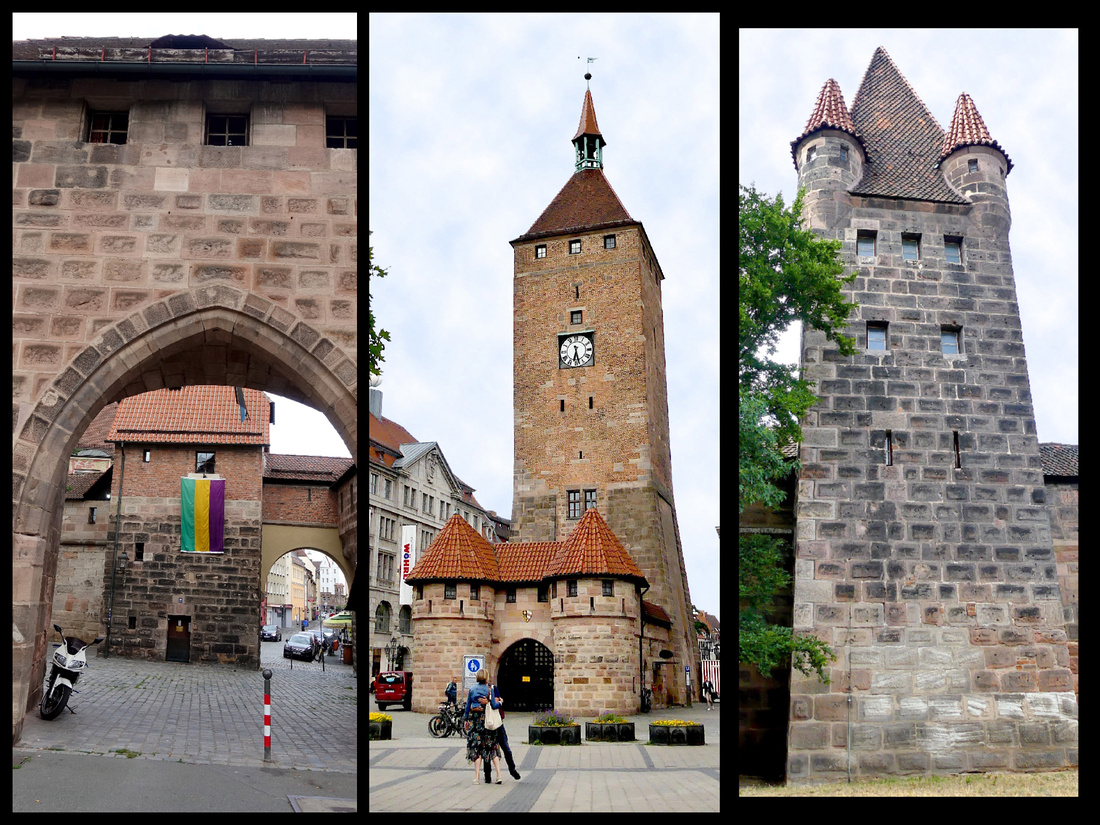
 Above center: the Weisser Turn. Above right and left: sections of the extensive town walls with multiple towers.
Above center: the Weisser Turn. Above right and left: sections of the extensive town walls with multiple towers.
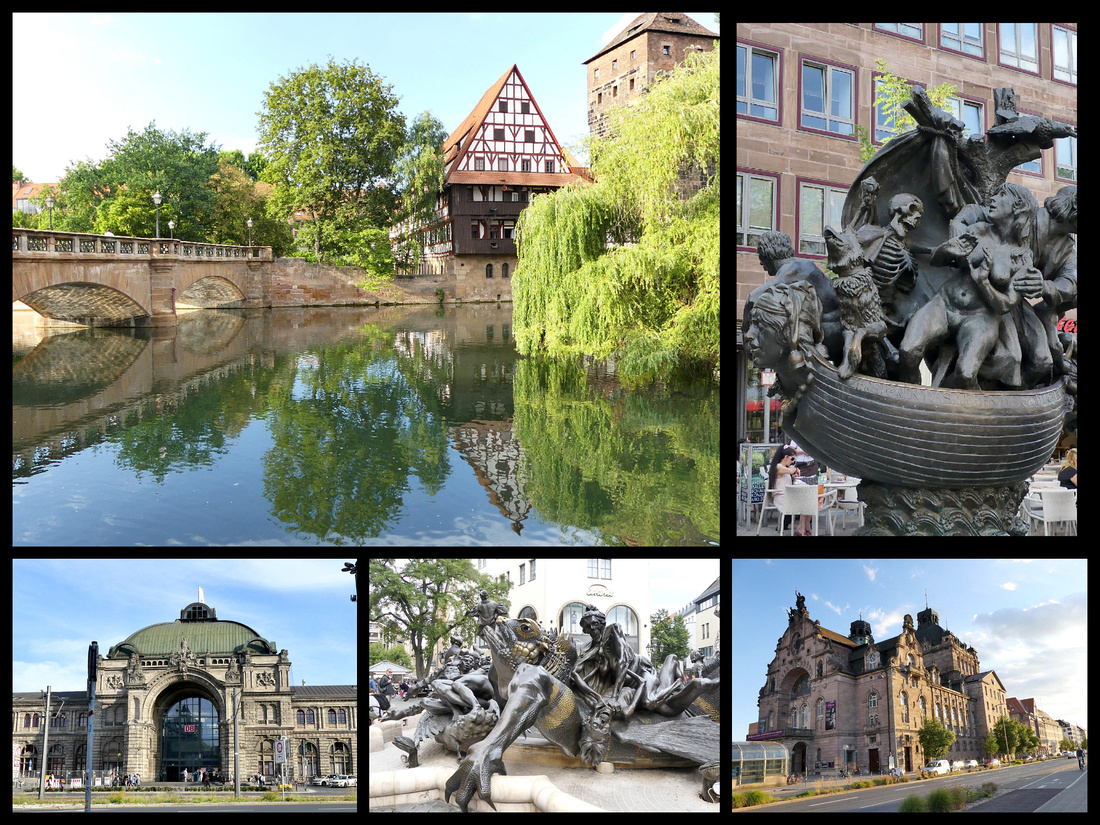

Above left: the Weinstadel reflected in the river Top right: fountain in front of St Lorenz
Lower left: Nurnberg train station Center: fountain in front of Weisser Turn Bottom right: Nurnberg Opera House (Nrunberg B&B Just past it)
One of our 3 days in Nurnberg we did a day trip to Bamberg
At a kiosk at the train station we got a VGN card for €19.70 which was considerably less than the Bayern card which is €31. Both are for two people, round trip, all day. We got the 9:38 train to Bamberg.
Bamberg is worth visiting for two reasons. One, it is a UNESCO town in it’s entirety with narrow cobblestone streets of ornate mansions, palaces, and churches, with styles ranging from Romanesque to Gothic, Renaissance to baroque, to the eclecticism of the 19th century. And two: it’s famous smoked beer. Bamberg has been called “a beer drinker’s Eden” (there are more breweries there than in Munich). The beverage of choice in Bamberg is Rauchbier, a smoked beer first brewed in 1536. My husband is a home brewer and self proclaimed beer snob and spent the whole trip trying different beers and this was his favorite.
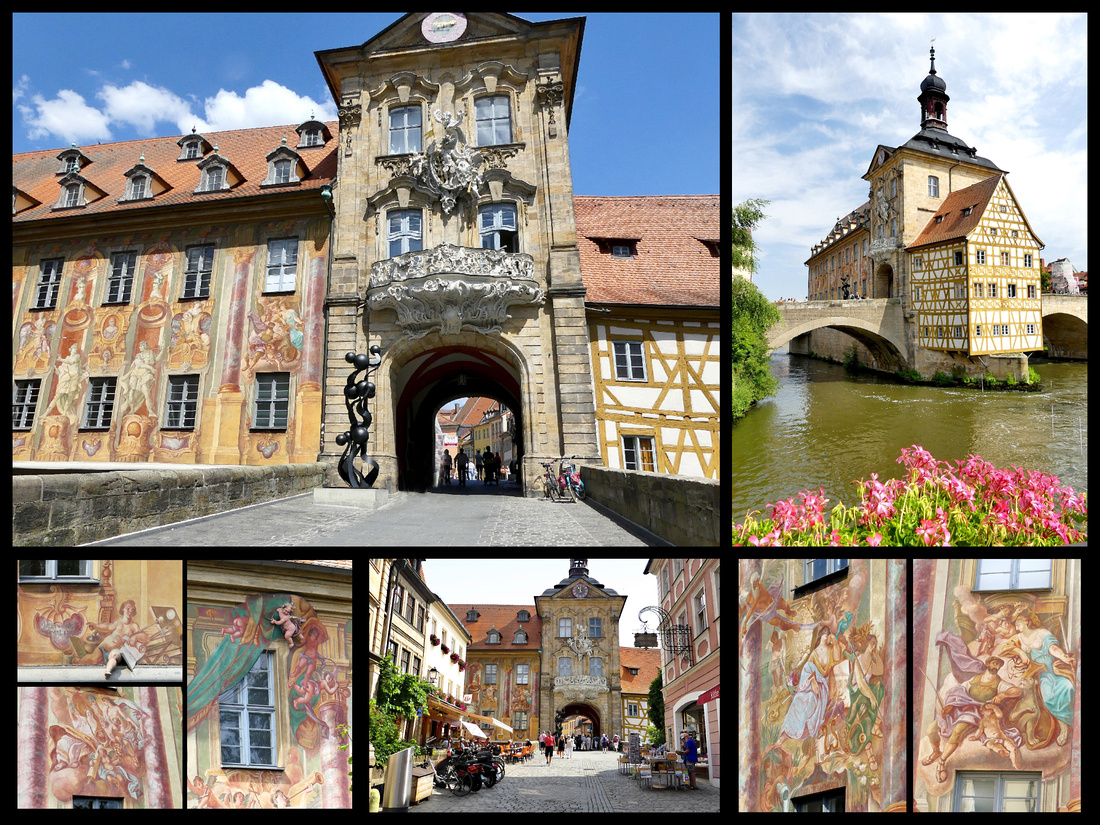

It’s a 30-minute walk from the train station to the Gruner Markt which is a long, pedestrianized square/street filled with market stalls of enticing looking fruits and vegetables. Just past that is the highlight of Bamberg, The Altes Rathaus, a gorgeous Gothic structure on its own little island in the Regnitz River. One part is half-timbered, the other covered on both sides with amazing frescoes. Determined not to play favorites between the ecclesiastical and secular sections of the city, the town authorities built this Gothic structure on its own little island in the middle of the Regnitz River, halfway between the two factions -- a true middle-of-the-road (or river) political stand. Right below it is ‘Little Venice’, a district of old fisherman houses along the river.


From the Altes Rathaus we headed to the Dom, passing The Schlenkerla Brewery, over 600 years old and its tavern is the only place in town serving the smoked beer from the barrels. Around the corner from the oldest brewery in town is the oldest pharmacy, the Hof Apotheke, in business since 1453.
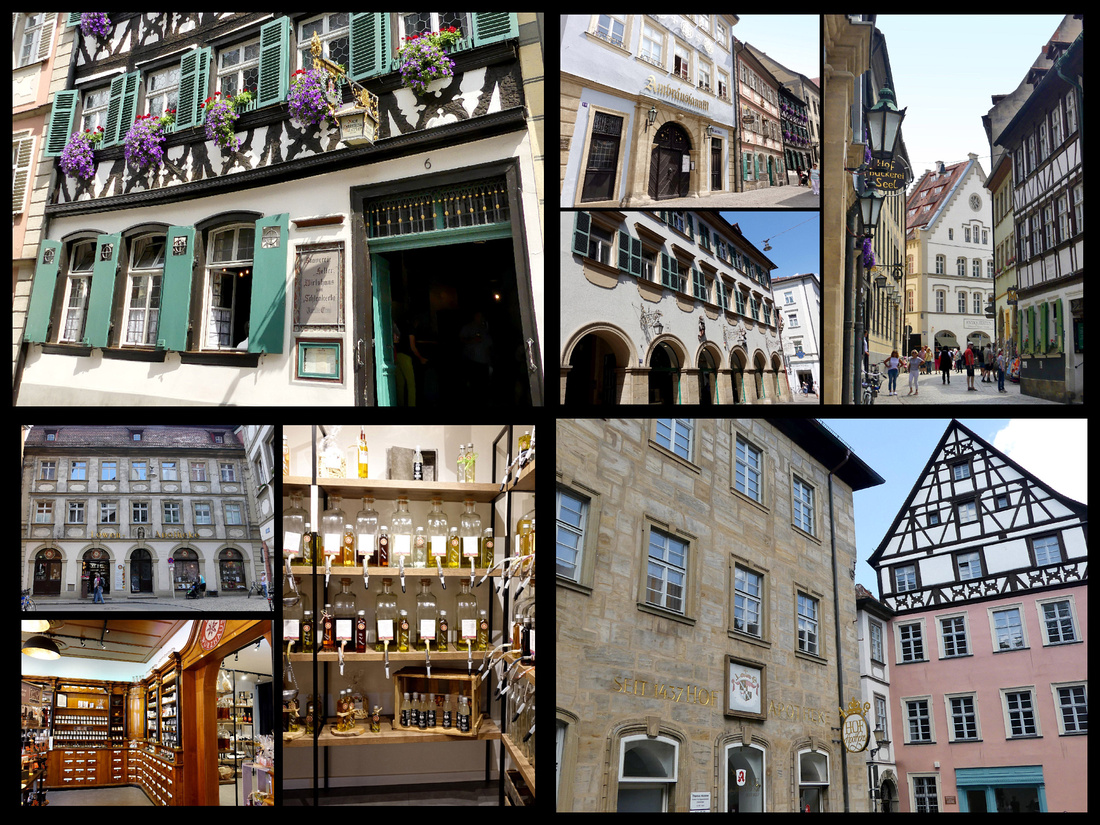

The Dom (St Peter’s and St George Imperial Cathedral, 11th century) shares it’s square (Domplatz) with the Alte Hofhaltung, a Renaissance palace with a courtyard surrounded with late Gothic half-timbered buildings. Across the square is the Neue Residenz, 1602 with a huge statue and fountain filled rose garden which supposedly has 4500 roses. Unfortunately all of these had a good deal of scaffolding around.
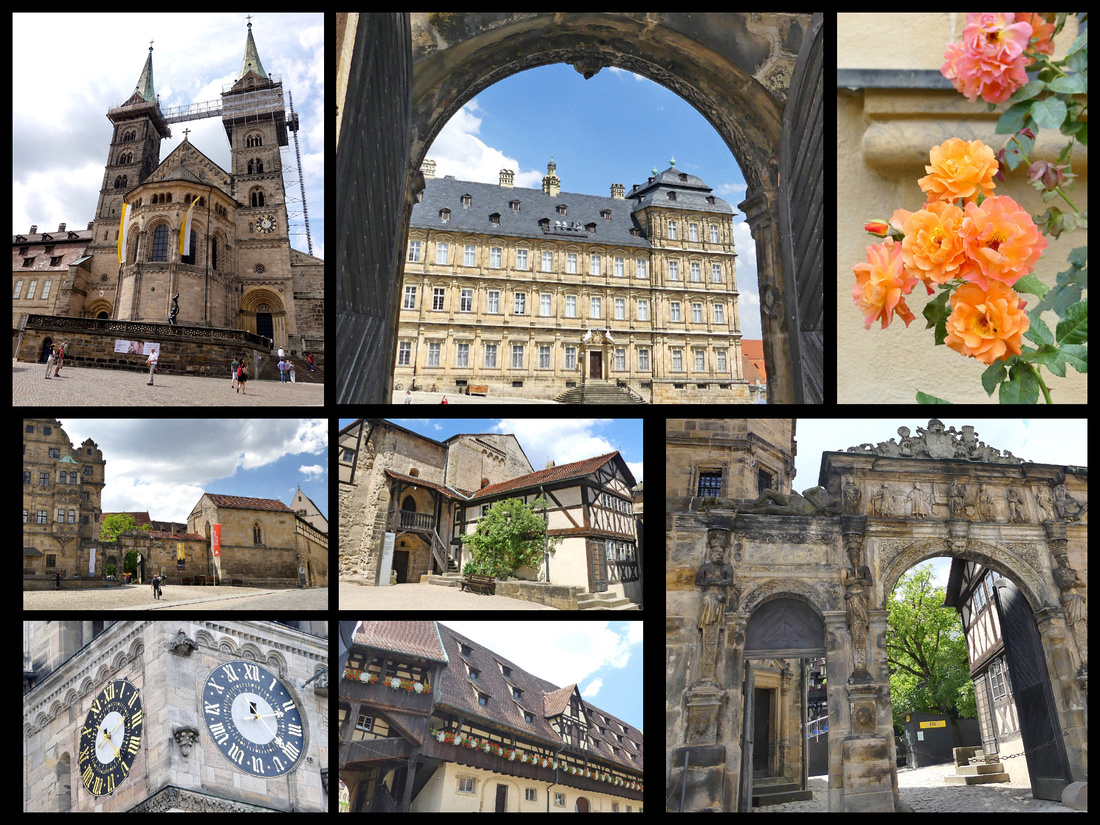

But one of the places we were most interested in visiting , Michaelsburg Abbey, a 15 minute walk up hill from Domplatz, was completely (and I mean completely) covered with scaffolding. And the Brewery Museum within it was closed. Bummer. However, this was all at least somewhat compensated for by the excellent lunch we had up there at the terrace restaurant, one of the two best meals we had on the trip, and of course they had the Bamberg smoked beer. The Michaelsburg torte we had for dessert wasn’t bad either. And there was a lovely view of the town below.


Regensberg Day Trip
We started the day with breakfast at the train station. Although Nurnberg Train station has several excellent places to get coffee, we just had to try the Dunkin Donuts. While Starbucks has been a common site in much of Europe for the past decade, I had no idea anyone in Europe had ever even heard of Dunkin Donuts but Nurnberg has at least two. The coffee was just like the Dunkin Donuts at home. Couldn’t bring myself to have donuts though when there were all those croissants only steps away though. Then we bought a Bayern ticket for €31 and got the 9:34 train to Regensburg (1 hour).
Regensberg train station is only about a 15-minute walk to the center. Although Regensberg is another UNESCO city, I was not as impressed with it as I thought I would be (this does not mean I didn’t think it was a beautiful city worth visiting, just that it didn’t live up to my very high expectations of it). There was even more construction than in the other cities (and they all have some) as well as lots of trash bags piled up awaiting pick up. There seemed to be a lot of vehicles, especially vans and trucks.
Regensberg is located on the Danube River and contains many medieval buildings of exceptional quality that testify to its history as a trading center. It has ancient Roman, Romanesque and Gothic buildings including patrician houses and towers, and a large number of churches as well as a 12th century Old Bridge. Regensburg is one of Germany’s best-preserved medieval cities and the only one to remain completely unscathed by World War II bombings. Strategically poised on the northernmost reaches of the Danube River, Regensburg was a Celtic settlement, then a Roman outpost, and the center from which, beginning in the 7th century, Christianity spread throughout Germany and into central Europe via the Danube. Regensburg was also a major hub for trade, and by the 12th century the town was pouring its wealth into churches, towers, and some genuinely lovely houses and public buildings. Two of Regensburg’s more famous contemporary residents have been Oskar Schindler and Pope Benedict.
When we first got there it was quite sunny, lots of blue sky. There are some lovely old buildings but there was some modern stuff interspersed as well. The Dom looked a lot like the one in Nurnberg. Steinerne Brücke is the stone bridge over the Danube, built in 1135, with 16 arches, a beautiful bridge, unfortunately it was half in scaffolding. It was the only stone bridge crossing the Danube from Vienna to Ulm for over 800 years. The clock tower/arched entry to the bridge is gorgeous and there are nice views from it, especially of the Salzstadel (Salt Warehouse) right next to it, built in 1620, an interesting building that was important in the active salt trade in the region. The best views of both of these are from the next bridge down river. There are several boats docked between them including a museum boat, and boats leaving for day cruises.
The Porta Petoria from the 1st C AD. is just a small corner of a building really, but a well preserved Roman ruin nonetheless. The main square, the Haidiplatz is really pretty, lined with beautiful buildings. The Altes Rathaus in Rathaus Platz (houses the TI office) adjoining Haidiplatz is one of the prettiest buildings in the city. There are numerous towers scattered about the alstadt (old town). There were a few other squares but none terribly inviting. We had read about the view from the top floor restaurant of the department store in one of the squares so we checked that out but the view was not great. The Alter Kornmarkt sounded like it would be a pretty square but was essentially a parking lot. However, it is the site of the Alte Kapelle, a rather boring church from the outside but a definite “WOW” inside – very beautiful baroque. One of the more unusual sites is the Goliath House, built about 1260, the largest mansion in Regensburg but the best part is the 1573 painting of the flight between David and Goliath covering two stories of the outside of the building. We were just starting to check out some of the lesser sites when it got cloudy quickly and then there was a sudden massive thunderstorm – now that was impressive. Fortunately we found an enclosed alley and waited it out for about 15 minutes. Then it slowed to drizzle but by that time I was not interested in any more exploring – combo of weather and just the town itself.
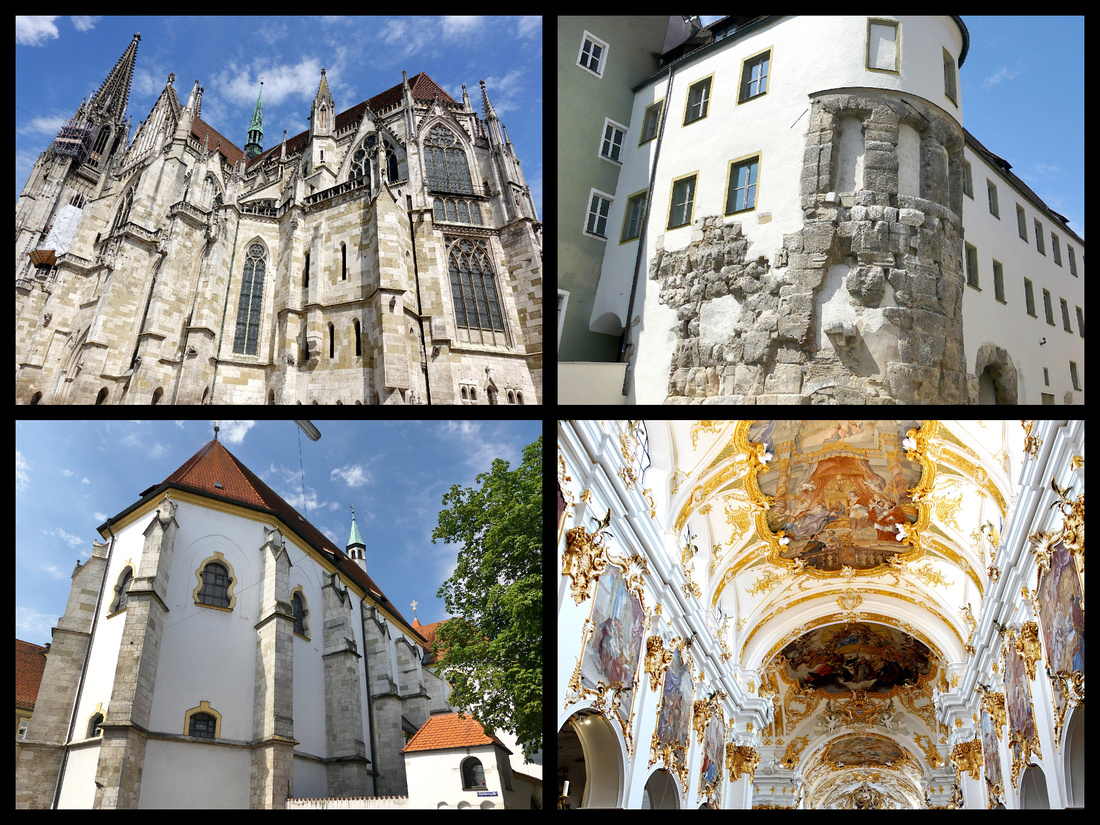

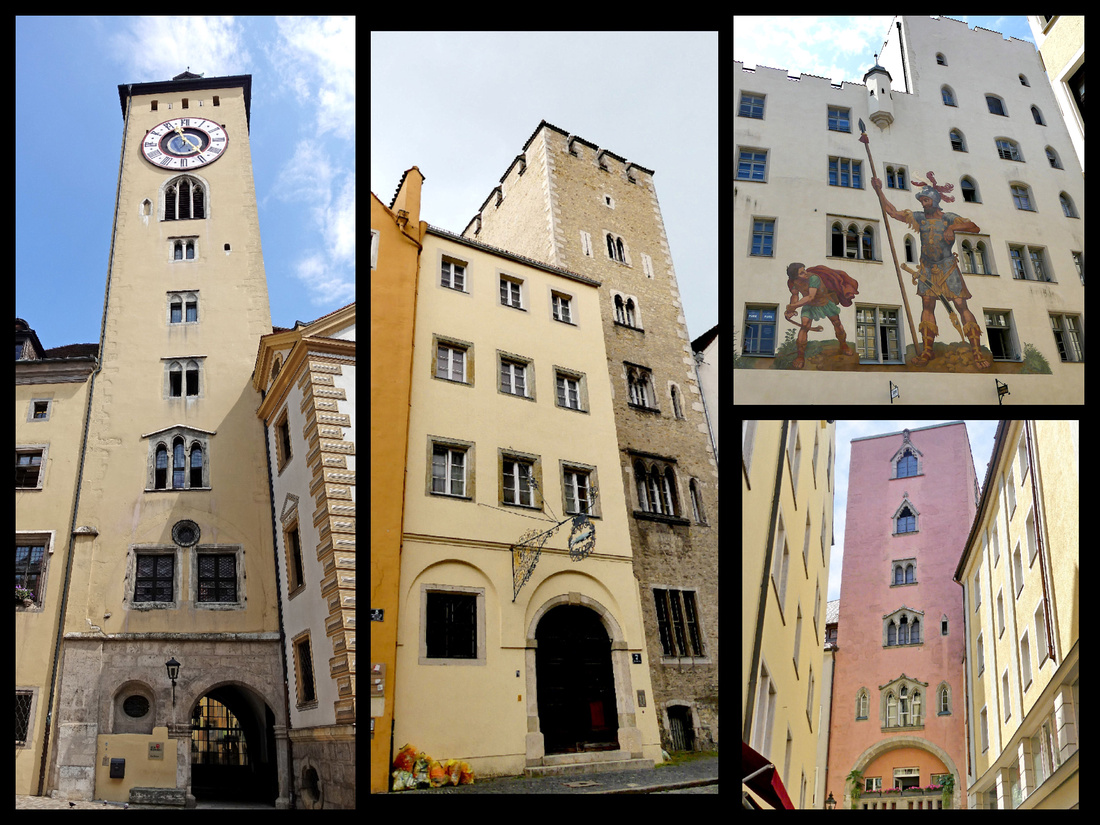

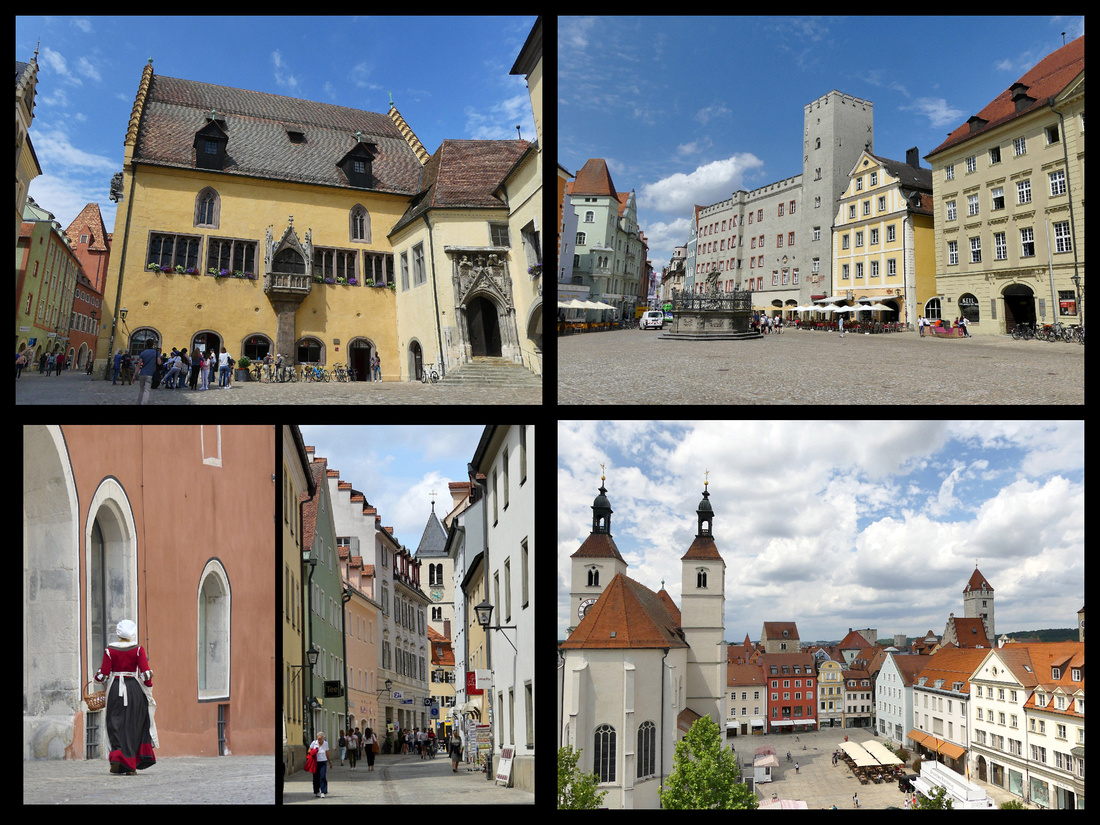

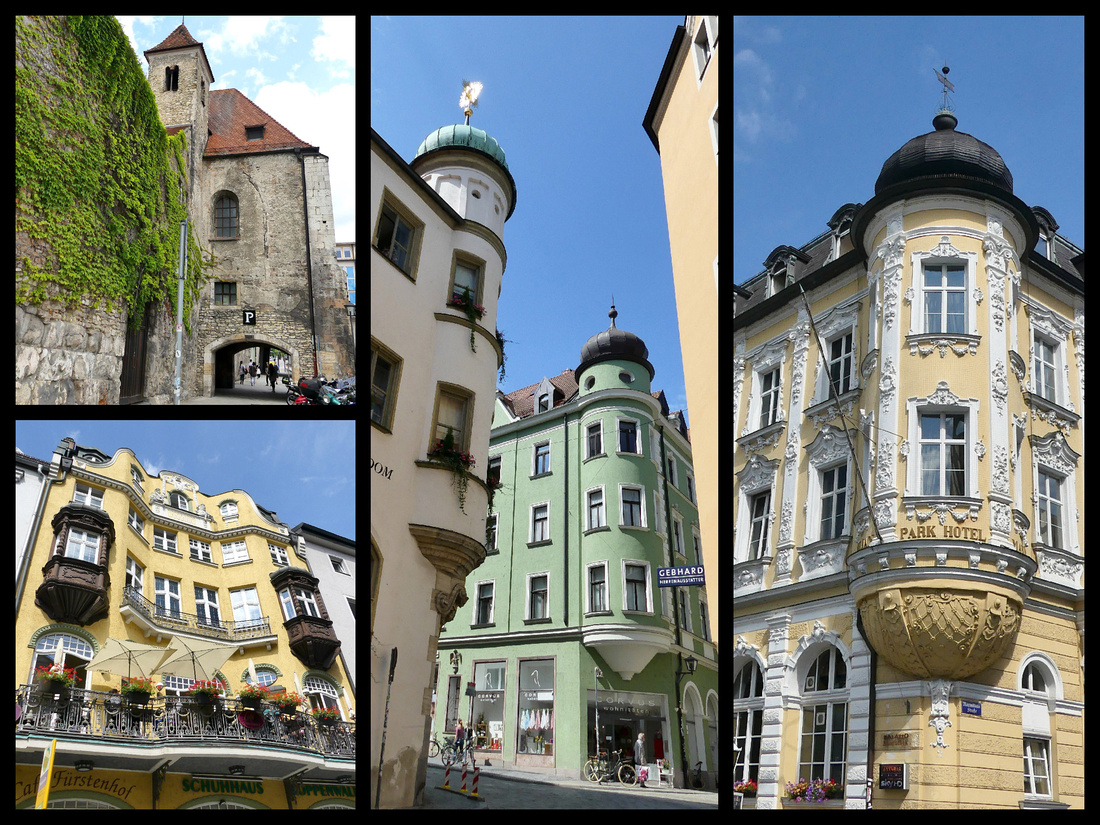

Day 17 - We spent the morning doing the few things in Nurnberg we hadn’t yet done (touring the castle and the Albrecht Druer House) and then took the 12:30 train to Rothenburg ob der Tauber ((VGN ticket). The whole trip was only about 1½ hour but required two changes, one 4 minute and one 5 minute but we made both easily, both trains were on time. We wanted a late afternoon and a morning in Rothenburg to try and avoid the crowds so booked just one night and this plan worked well. An afternoon/evening and a morning were just about right. Hotel Zum Breiterle is just inside the walls, a ten-minute walk from the train station. The hotel is a nice old picturesque house, inside not exactly modern, but clean and comfortable.
ROTHENBURG OB DER TAUBER – “Red fortress on the Tauber river” is every bit as gorgeous as everyone says it is. Surrounded by massive stone walls (most of which you can walk) with 42 towers and several gates and full of cobbled streets lined with gorgeous buildings and flower filled window boxes, a beautiful main square with amazing buildings, and a picture postcard perfect intersection of two streets with a gate and fountain. The walls were great fun, most of it free and the bastion at the south end of town also incredible and free. So Rick Steves is right, Rothenburg is the quintessential German medieval town. Looks like a movie set except for all the cars everywhere. Reminded me a bit of Brugge only with walls instead of canals. Rothenburg, like Brugge, was poor in the 17th and 18th centuries when richer towns were tearing down the old stuff and building Baroque and later, so it remains very medieval.
ButI was really surprised that they don't restrict at least the parking of cars in the old center. The tour groups everywhere mid-day I expected (that's why we spent the night), but the cars I didn't expect. We had just about 24 hours in Rothenburg which was perfect. We arrived around 2 pm and the town was jammed, by 7 pm we almost had the place to ourselves. The following morning the town was delightfully empty (except for the delivery vans) until about 10:00 when the tour groups arrived.
We entered the town through the Roder Gate - late 14th century and still has its toll both and gatekeepers cottage in front of it, the tower is the only lookout tower along the city walls.
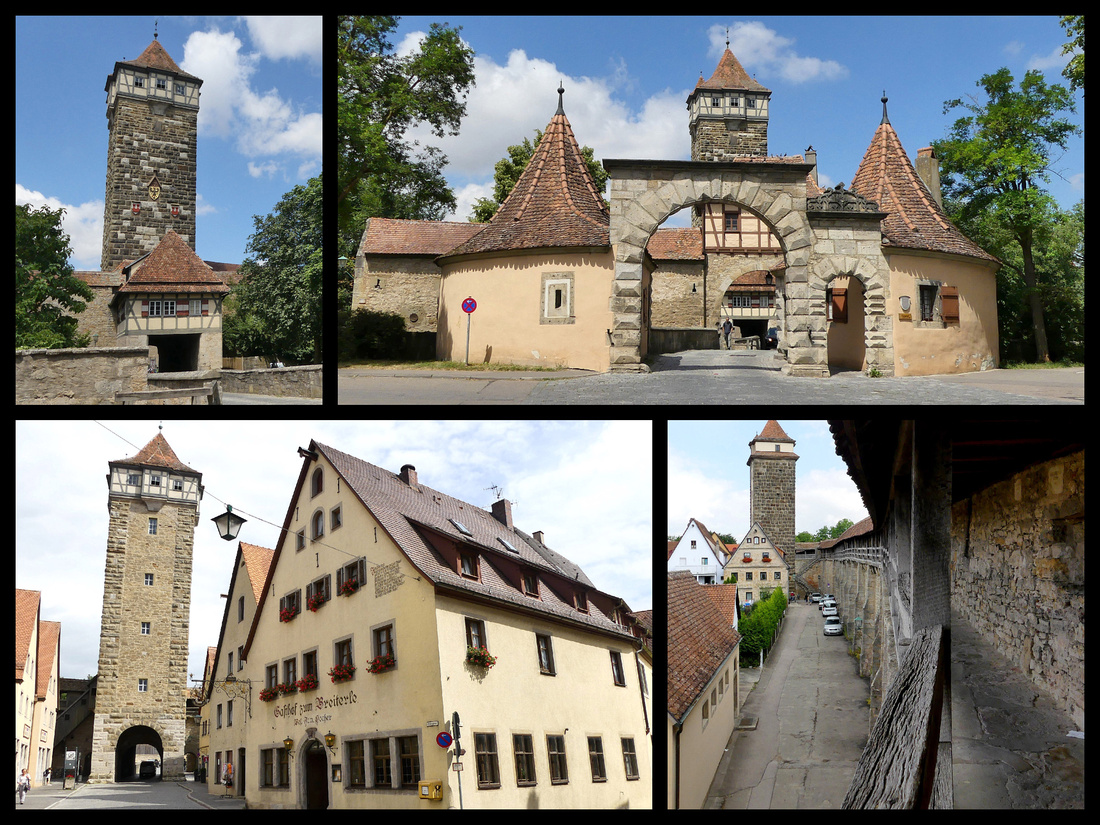

Inside, a few blocks towards the center is the Markus Tower which was part of the city’s first fortifications in 1200.
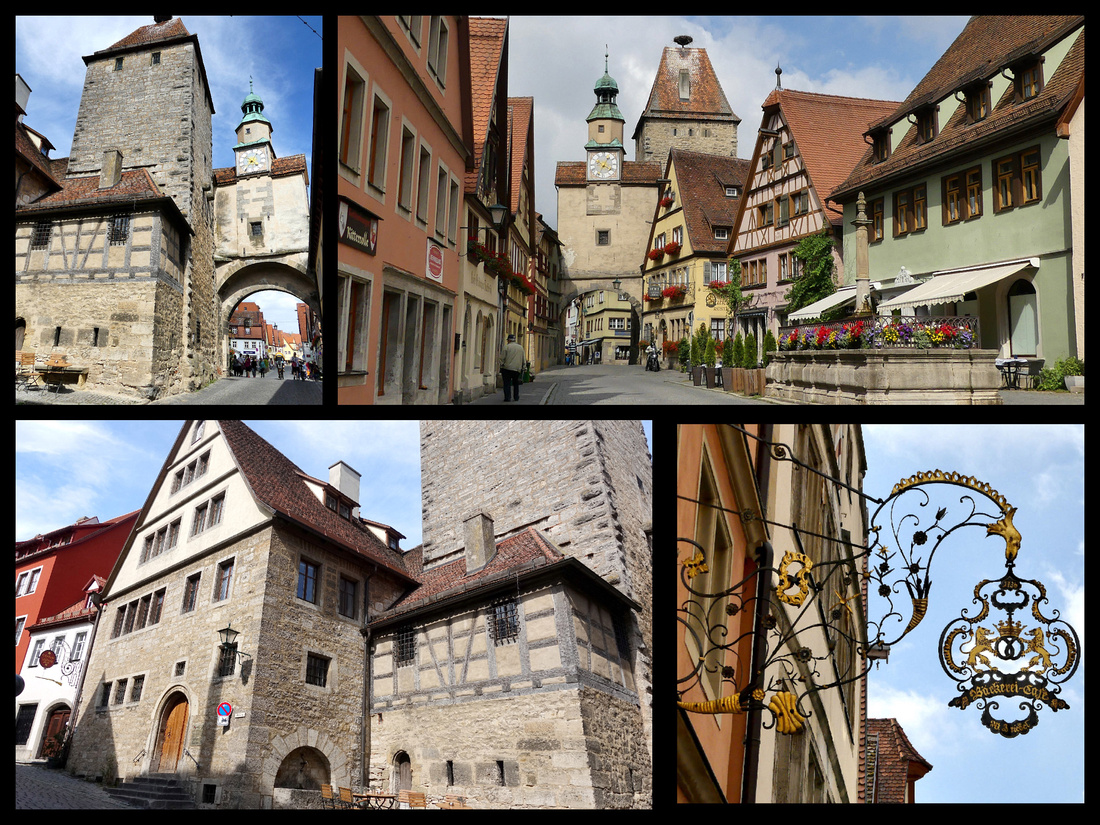
 Above: Markus Tower, lower left: The Büttelhaus (Beadle House) which is now used to store the city archives has a very small door into the former prison.
Above: Markus Tower, lower left: The Büttelhaus (Beadle House) which is now used to store the city archives has a very small door into the former prison.
The center of Rothenburg is Marktplatz (Main /Market) Square. The main building – Rathaus (Town Hall) is Gothic (1250-1400) at the rear and Renaissance (1572) in the front. Next to it is the Rathstrinkstube (City Councilor’s tavern), which features a beautiful front with astronomical clock. One corner of the square is George’s Spring, the largest in the city, 25 feet deep. The pillar above it is Renaissance (1608). We climbed two sections of wall and walked most of the circuit, some of it twice. We climbed to the top of the city hall tower which has great views of the square below and the entire town. The first hundred steps or so are stone spiral, very wide and easy. Then comes a series of wooden steps, getting more and more narrow and steeper as you go for another hundred or so steps. The final section is essentially a ladder. With (very small) backpacks we barely squeezed up there - certainly no one with mobility or weight issues could make it. That last part you climb, not walk. But it was fun. Interesing that the ticket desk ($2.50) is at the top. Due to the small space up there only 20 people are allowed at a time. About halfway up is a turnstile with a light - if green it lets you go, if red you have to wait till some people come down.


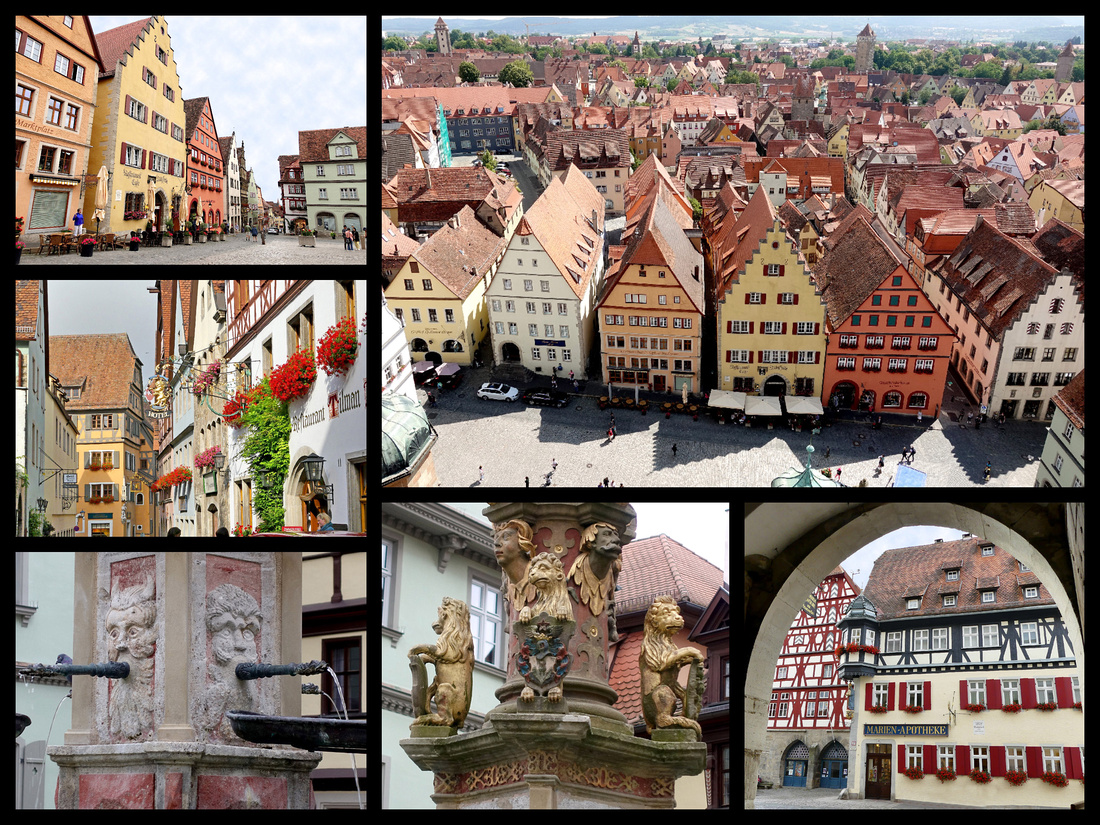
 Above: Marktplatz from tower of Rathaus. Lower left and center: close ups of St George's Fountain.
Above: Marktplatz from tower of Rathaus. Lower left and center: close ups of St George's Fountain.
The Schmiedgasse leads off from Marktplatz down to Plonlein/Siebers Tower, the most photographed place in town (where every selfie taking tourist insists on posing). Plonlein means ‘little square’. It dates from 1385. It actually is the most photogenic spot in a very photogenic town.

 Above - Top Left: The Plonlein and Siebers tower Top right: Kobolzeller Gate
Above - Top Left: The Plonlein and Siebers tower Top right: Kobolzeller Gate
Lower left and center: Schmiedgasse leads from Marktplatz to Plonlein Lower right: fountain in Plonlein
We also checked out St Jacobs-kirche, which is on one of the northern routes to the Camino de Santiago, (where we spent our trip last summer) and sure enough, there is a bronze statue of St James with the scallop shell in his hand right outside – and the bronze scallop shell markers on the ground pointing the way to Santiago.
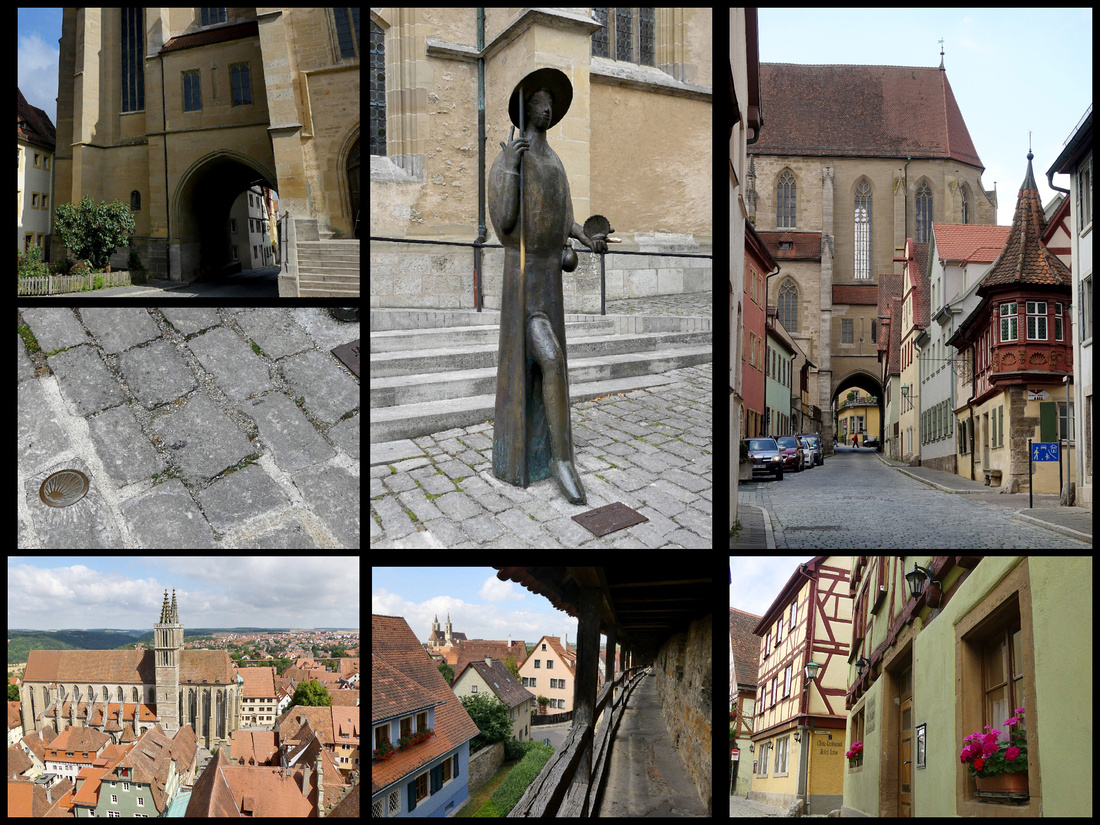

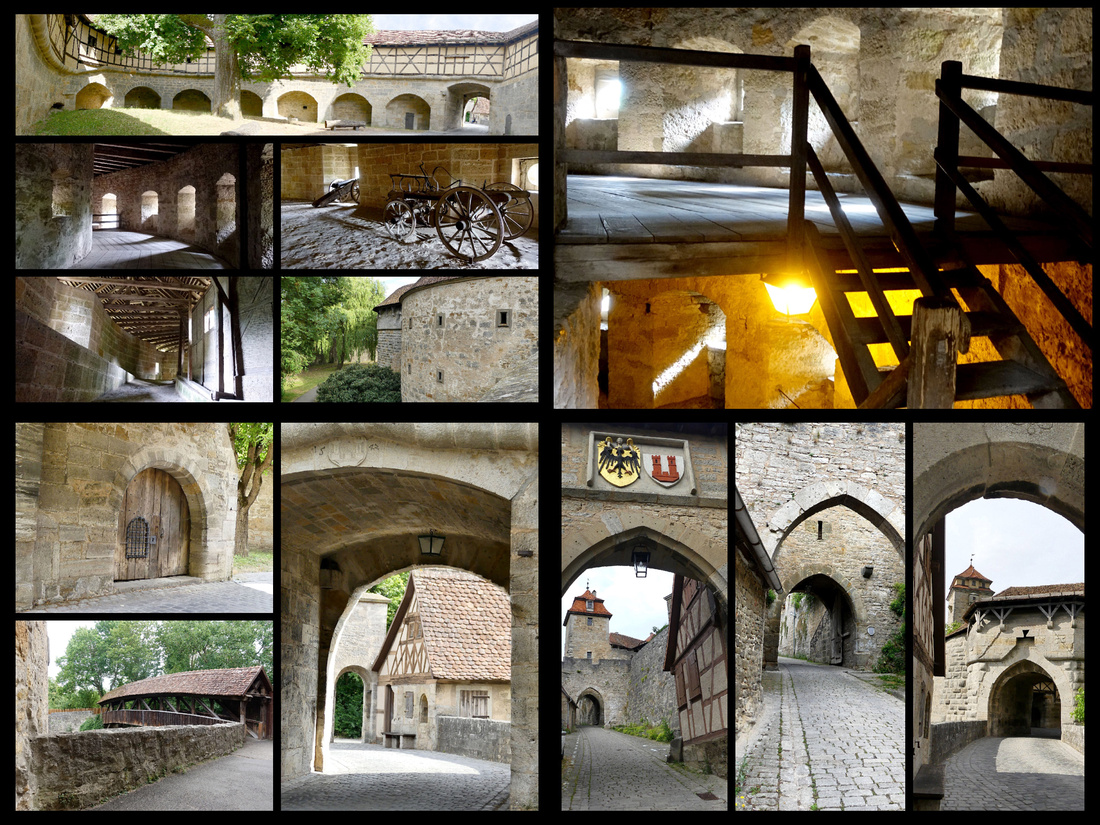

Castle (Burg) Gate & Tower was at the site of the castle which is no longer standing but the gardens remain. There is a mask with a ‘mouth’ through which the castle’s defenders poured hot tar onto attackers. The side doors were deliberately small so that only one person at a time could enter.

 Above: Castle Gate and gardens Lower left: the 'Double Bridge as seen from Castle Gate Lower center & right: Castle Gate tower from town side
Above: Castle Gate and gardens Lower left: the 'Double Bridge as seen from Castle Gate Lower center & right: Castle Gate tower from town side
Above: Klingen Gate and one of the entrances to the town walls
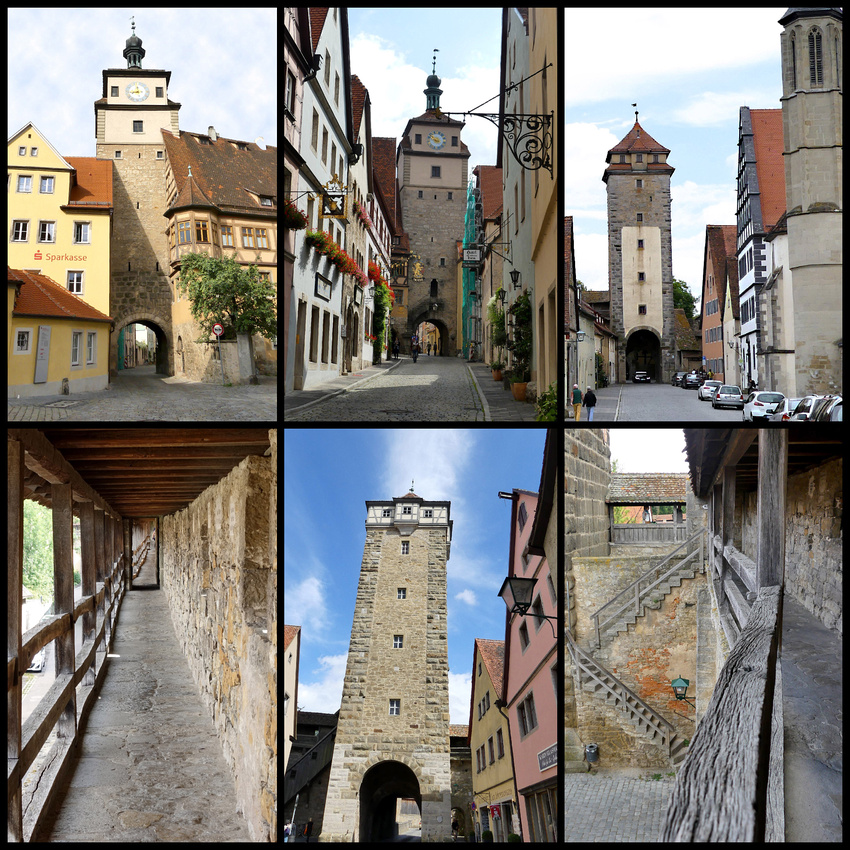

Above - top left: White Tower (from outside the walls) center: White Tower from inside top right: Gallows Gate/Tower
lower left and right the 12th-13th century walls lower center: Roder tower


Days 18-19 - Heidelberg
Heidelberg didn't exactly fit with the rest of the places we visited which were all in Bavaria but we needed to be close to Frankfurt to fly out and it turned out Heidelberg was perfect for the last couple days of the trip. We didn't arrive until early evening but had time to walk to the historic center (from our hotel which was across the square from the train station) for dinner. The pedestrian shopping street, Haupstrasse, was lively and pleasant, with some interesting historic buildings including the university, and leads to the main square - Markplatz - with great views of the highlight of Heidelberg - the 'half-ruined' castle on the hill.
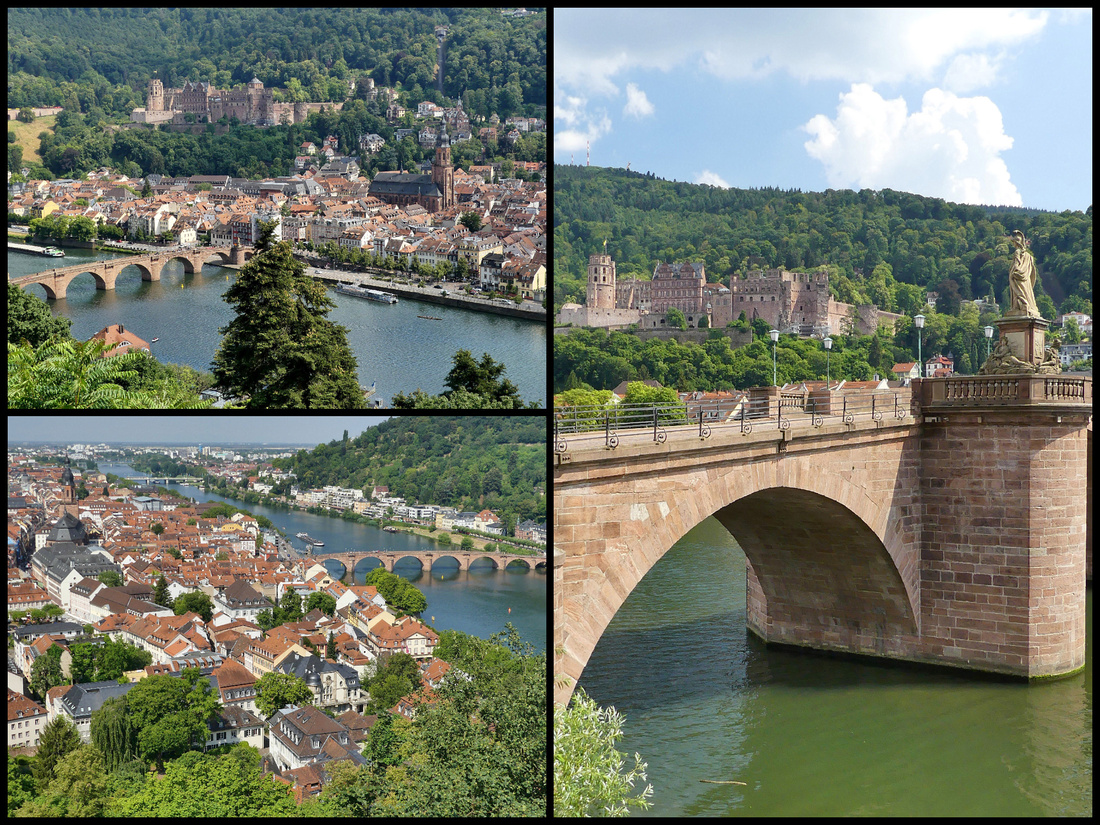

Marktplatz has the most impressive church in the city, Heliggeist-kirche as well as the Rathaus. The adjoining square is the Kornmarkat which was a grain market in the middle ages, nice fountain in the center. The entrance to the funicular is just off this square.
We took the funicular up to Heidelberg Scholss. It’s 7€ each for the funicular plus the castle grounds, the old apothecary and the giant casks. If you want to tour the rooms you have to buy a separate ticket for a guided tour. We took the funicular to the station above the castle and walked down thinking there might be nice views of the castle from above. It was an easy 15 minute walk but the view of the castle from the grounds (Schlossgarten) was even better. There are quite a lot of grounds outside the castle (with panoramic views of the town, the old bridge and the river) and the courtyard is quite large.
Perched on a hill overlooking the city, the ruins of Heidelberg Castle is the result of many centuries of building and destruction caused by war, fire and pillaging. The earliest fortifications were in the 13th century; most of the present structures date to the Renaissance. While much of the castle remains in a state of artful decay, some areas have been renovated to its Gothic glory. Even in ruin one of the great Renaissance landmarks of northern Europe suggests beauty, grandeur, and long vanquished empires—in this case a division of the Holy Roman Empire, whose prince electors lived here from the 13th century. Very interesting contrast with some of the castle in great shape – with lots of intricate carvings on the exterior walls, etc., yet the rest of it is a ruin.


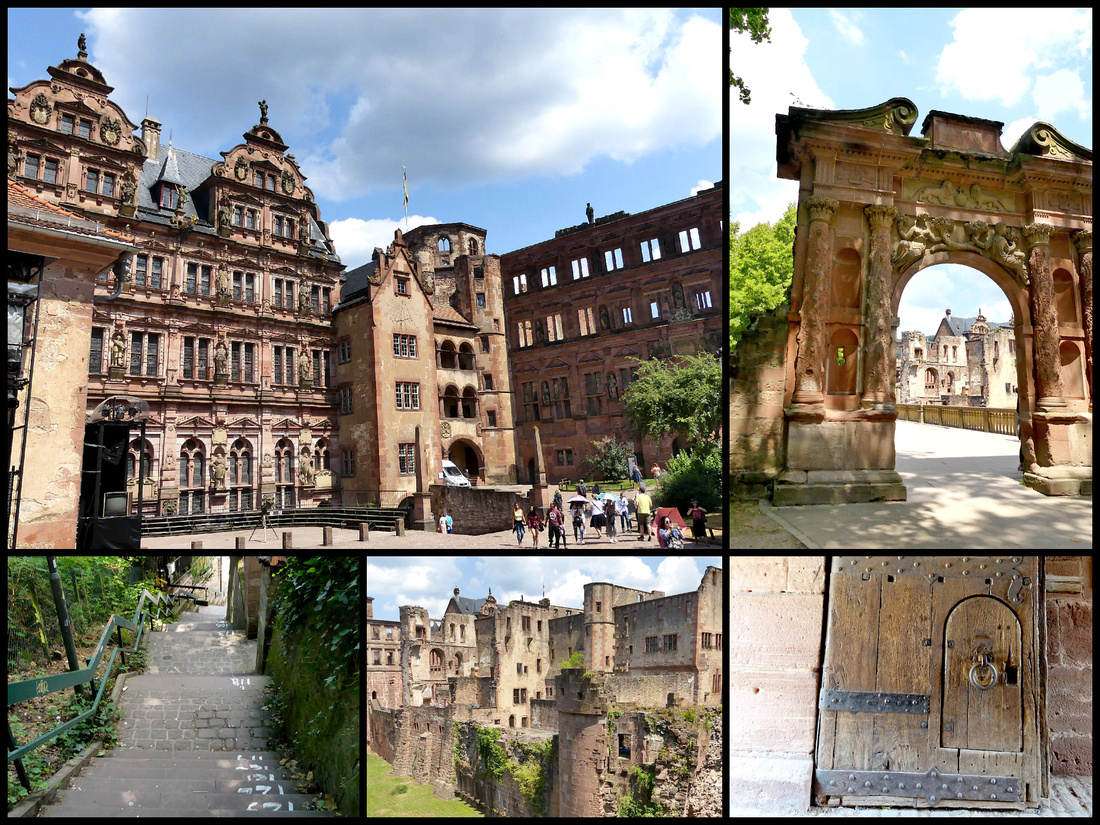

The Great Cask, aka the Heidelberg Turn, a symbol of the exuberant life the prince electors enjoyed, was built in 1751 to store more than 208,000 liters (55,000 gal.) of wine (the largest in the world) but failed to impress Mark Twain, who wrote, “An empty cask the size of a cathedral could excite but little emotion in me.” The cellars house the giant casks (there are three, besides the Great Cask). The biggest cask is in a room by itself with a beautiful wood spiral staircase going to the top of it. The others are in a large hall like space that is also a wine tasting bar and a food/beer/beverage bar. We got white sausage with sweet dark mustard, beer and ice tea. Same meal that was our first of the trip in Munich.
The Chemist’s Tower houses the Apothekenmuseum (Pharmaceutical Museum) and the old chambers spotlight the importance of German pharmaceutical research (much of it conducted at Heidelburg University) with utensils, laboratory equipment, and re-created chemist’s shop from the 18th and 19th centuries. The apothecary museum is extensive and one of the best I’ve seen (probably second only to Krakow). Many rooms, lots of apothecary chests (room size) and jars and jugs and miscellaneous other materials used in pharmacy. Lots of explanations on the history of pharmacy, all in both English and German. Nice little crocodile hanging from the ceiling.


Although the funicular back down to town is included with the ticket we had, we choose to walk. It’s only 220 steps (and they had painted numbers on them).
On the other side of the bridge from the alstadt is the “Philosophers walk” (Philosophenweg )– up a rather steep hill, then along the river, through vineyards and woods. Fabulous views back to the old town with the castle above it and the old bridge over the river. The town is definitely better from a distance – but from a distance it is a stunner.
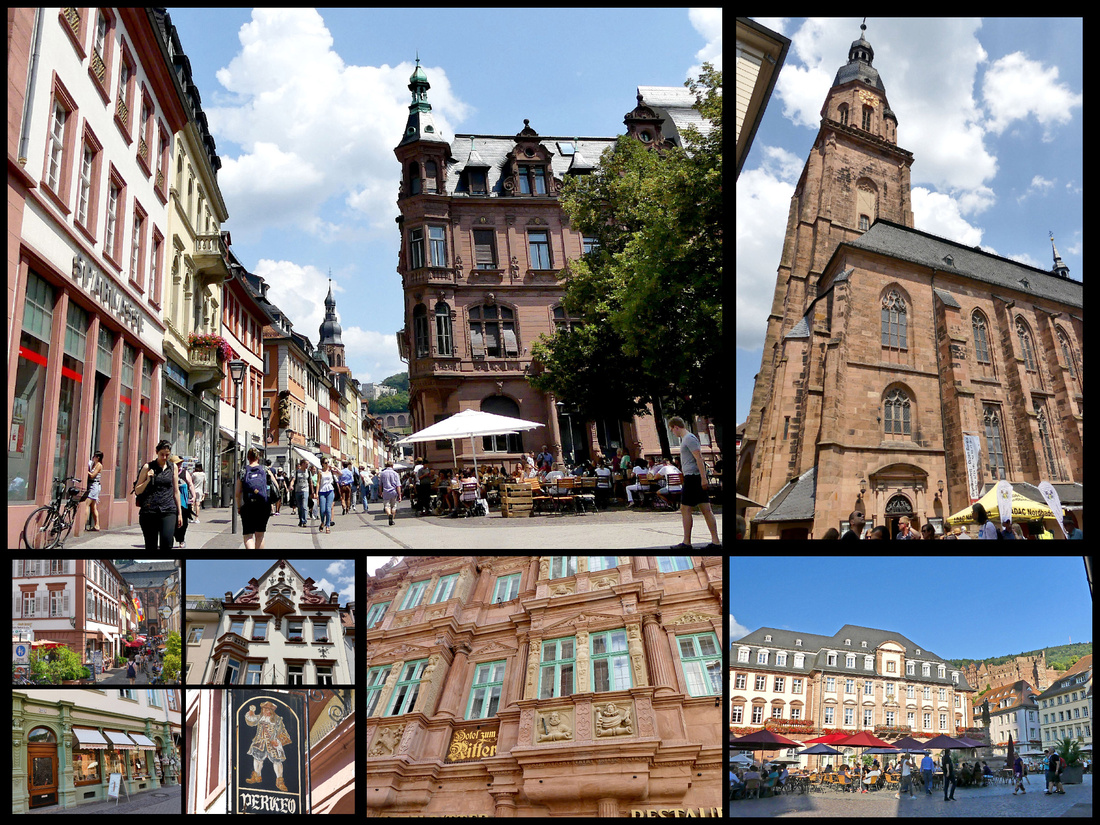

Comments
Have you been to Munich and Salzburg? Unmissable both cities. We have done two toursoverlapping Germany and Austria then Eastern Europe. Your reviews mirror our own sightseeing, so if you would like to correspond please do.
Thanks and once again a fantastic blog.
Robert and Barbara Harry
